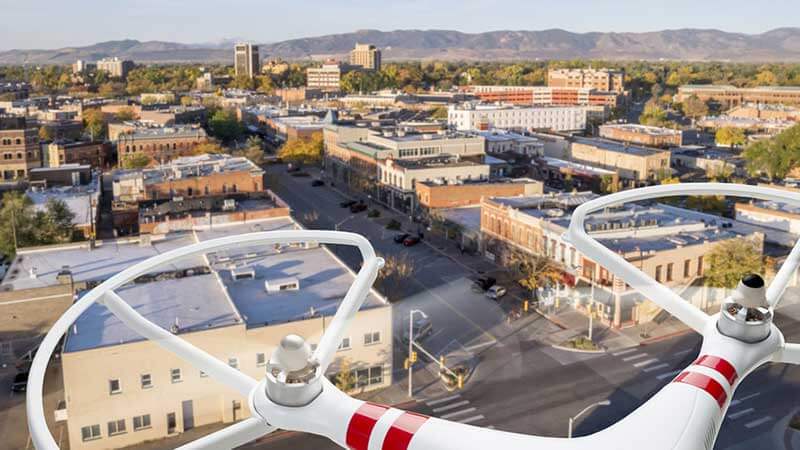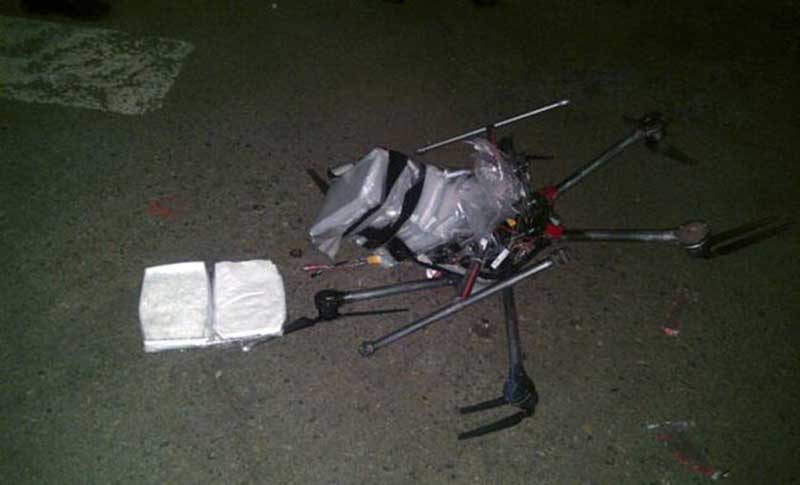- Drones have a right to fly over your home
- High-tech peeping Toms meet angry homeowners
- Police tackle drone crime with humour
- Drones ferrying contraband to convicts
- Drones as drug mules
- Police eagles: the future of crime-fighting?
Drones are taking the world by storm. They’re cheap, fast, and powerful – a winning combination for hobbyists and industry alike. In fact, the very things that make them fun to fly make them ideal for inspecting bridges, delivering packages, and surveying rough terrain. But as their popularity takes off, so does their misuse. Savvy criminals – from drug runners to the pervert next door – are figuring out what drones can do, while the public is left guessing about the future of crime.
Drones have a right to fly over your home
Peeping Toms are nothing new. But camera-equipped drones are taking snooping to a new level. Quiet, inexpensive, and agile, drones are a new threat to privacy. While homeowners maintain some control over the airspace above their property, fly-over rights are guaranteed to aircrafts. These legal precedents were set when airplanes and helicopters were the only issue; no one imagined drone overflight in 1958 when Newark v. Eastern Airlines, Inc. was decided – the pivotal court case that decided the overflight law in the US. In fact, the Federal Aviation Administration (FAA), the regulatory agency for aircrafts in the US, has made it clear that drones are entitled to the same legal protections as planes. But as angry people in America reach for their guns, the authorities want people to calm down. Joseph Lamonaca, a Safety Team Representative for the FAA, explained to the Daily Mail that “anyone who just threatens to shoot down a drone could get five years in prison. That means, telling your neighbour that you are going to shoot down their drone can put you in jail.”

High-tech peeping Toms meet angry homeowners
But in practice, the law has been anything but sympathetic to peeping Toms who have their drones annihilated by angry homeowners. The legal system allows judges the discretion to differentiate between threats to 747s and shooting at intrusive, peeping drones – and they’re using common sense to distinguish between cases where the law should interfere and those in which it should side with the shooters! In 2015, for instance, a Kentucky man noticed a low-flying drone hovering over his backyard – and his sunbathing daughter. The third time the peeping drone appeared, William Merideth grabbed his shotgun and blew it out of the air. Merideth was initially arrested, but the judge hearing the case later dismissed the charges. “He had a right to shoot at this drone, and I’m gonna dismiss this charge,” she ruled. Several states are now considering legislation to allow homeowners the right to forbid drones over their property.
Police tackle drone crime with humour
We’d like to think that this 21st century peeping is rare – but it’s not. Rachel and John Henson, a couple living in Utah, noticed a drone hovering just beyond their bathroom window. According to Rachel, her “husband was getting ready for work and he shut the shower off and heard the whirring of the drone”. As John tells it, “[i]t was very nerve-racking. It made me pretty nervous.” He got angry and decided to follow the drone with his car as it sped away. Eventually it landed in a church parking lot, where John grabbed it and accessed it’s on-board memory card. What he found had him on the phone with the police – the peeper had been recording people in their bedrooms.
The Orem Police Department took this crime seriously, reacting with stunning humour. On their facebook page, they posted a picture of the drone on top of their logo with “We found your drone!” written above it. In their feed, the cops wrote, “Are you missing a quadcopter? Does the SD in your quadcopter camera have videos of people in their private bedrooms and/or bathrooms? Would you like to turn yourself in before we have to come knocking on your door, maybe on Christmas morning, with a warrant?” The allegedly peeping couple eventually did turn themselves in.
Drones ferrying contraband to convicts
But invasion of privacy is just the beginning. Drones are versatile platforms that can lift and carry small loads at up to 160 km/h, and they’ve become the tool of choice for drug smugglers. This may sound outlandish, but it’s already happening. In late April last year, for instance, Daniel Kelly flew his quadcopter over the walls of Swaleside jail in Kent. Laden with contraband dangling from a hook, his plan was to deliver tobacco and synthetic marijuana to the prisoners in lock-up. He was only caught when police noticed a suspicious vehicle close to the prison. This was his mobile HQ for smuggling, a necessary danger given the relatively short ranges of drone transmitters and receivers. When the police opened his trunk, they discovered the ‘blacked-out’ drone, spray painted and taped to make it invisible against the night sky. According to the Guardian, a quick check of the drone’s software “revealed it had made flights to HMP Elmley in Kent on 20 April, HMP The Mount in Hertfordshire, on 23 and 24 April and HMP Swaleside on 25 April”. Unsurprisingly, he’s now in jail himself.
But don’t underestimate the danger that Kelly’s stunts pose – they’re far from fun and games. Criminals like him could potentially deliver hard drugs, smartphones, and even weapons to people in prison, and jails aren’t constructed to prevent aerial threats. In the US, similar problems are complicating efforts to keep drugs from crossing its borders. As Kelly’s arrest demonstrated, criminal pilots need to stay close to the tools of their trade, typically within 3 to 5 kilometres. But that’s about the only weakness this system has. Drones themselves are inexpensive and easy to operate, but the tech needed to disable them is enormously expensive. This has left US Border Patrol playing a complex game of cat and mouse with drug runners.
Drones as drug mules
Jorge Edwin Rivera was paid $1,000 to fly a drone with a 6 kilo cargo of methamphetamine across the border from Mexico. Rivera was hidden on the US side, and his goal was to pilot the drone across the border and into the desert, pick up a stash of drugs, and fly it back, where he would deliver it to an accomplice at a filling station. Luckily, Border Patrol agents spotted the drone, followed it, and soon found Rivera, drugs in hand. While not the preferred method for drug running – drones simply can’t carry enough weight – they’re devilishly hard to spot. Rivera admitted to 5 or 6 previous ‘deliveries’ over just a few months, and authorities really have no idea how common this method has become.

Police eagles: the future of crime-fighting?
The quick advance of drone tech has police and security authorities looking for realistic solutions and racing against time to counter the threat. Anti-drone tech is advancing, too, but it usually uses radio frequency interference to down its targets. Also, it can attack only one drone at a time, and costs a small fortune. But creative thinking might win the day for the good guys: Dutch and French security forces are deploying eagles – eagles! – trained to attack drones and knock them from the air. These anti-drone birds of prey are cheaper than other counter-measures, but still cost more than $150,000. They swoop in from the sky, hit the drone in mid-air, and push it to the ground where they wait for their human partners. Whether these police eagles are the future of crime fighting, only time will tell.
Share via:



